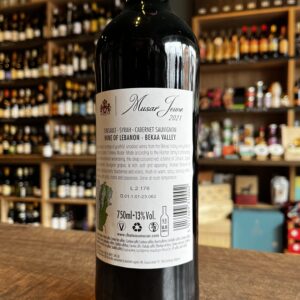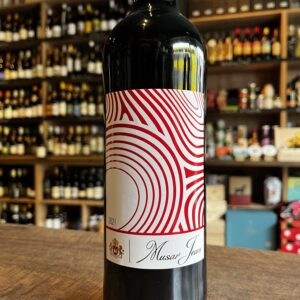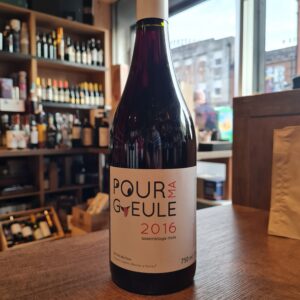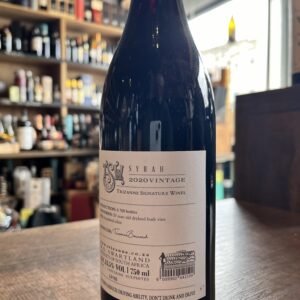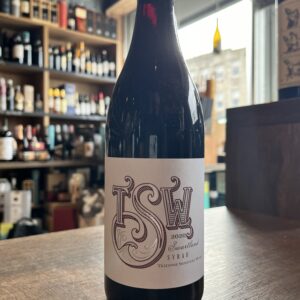Cinsaut or Cinsault is a red wine grape, whose heat tolerance and productivity make it important in Languedoc-Roussillon, Lebanon, South Africa. It is often blended with grapes such as Grenache and Carignan to add softness and bouquet.
-
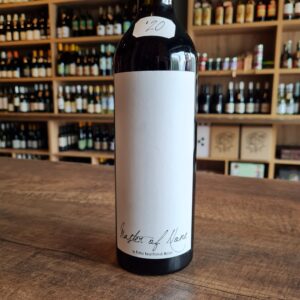 Master of none - Playing with words referring to themselves not being an expert in any one varietal or wine style hence the saying: “Jack of all trades, master of none”. Clever and humble, nonetheless, their wines are at the forefront not only of South Africa but in the world with the amazing wines they are producing. If you enjoy reds on the lighter end of the spectrum such as Pinot Noir or Gamay then Pieter's 'Master of None' will definitely be up your street! It comprises a blend of 5 different grape varieties from tiny vineyard plots across 6 distinct regions; 40% Grenache from Wellington, 30% Cinsault from sites in Darling and Stellenbosch, 8% Pinot Noir from Elgin and a further 8% Syrah from Swartland. Unusually, Pieter then tops up the blend with Voor Paardeberg Chenin Blanc, adding aromatic freshness to the finished wine. It drinks like a top-class Beaujolais – super bright and juicy, bursting with wild strawberry, cherry and with an earthy, smoky undercurrent. Enjoy at room temperature or slightly chilled – perfect for summer drinking! “In 2004, a lady came to my house to buy wine. She asked for anything but Shiraz. “I don’t drink Shiraz”, were her exact words. I poured her a glass of wine. She loved it and bought 3 cases. It was a straight Shiraz. It’s a fact – we do judge the book by its cover.”
Master of none - Playing with words referring to themselves not being an expert in any one varietal or wine style hence the saying: “Jack of all trades, master of none”. Clever and humble, nonetheless, their wines are at the forefront not only of South Africa but in the world with the amazing wines they are producing. If you enjoy reds on the lighter end of the spectrum such as Pinot Noir or Gamay then Pieter's 'Master of None' will definitely be up your street! It comprises a blend of 5 different grape varieties from tiny vineyard plots across 6 distinct regions; 40% Grenache from Wellington, 30% Cinsault from sites in Darling and Stellenbosch, 8% Pinot Noir from Elgin and a further 8% Syrah from Swartland. Unusually, Pieter then tops up the blend with Voor Paardeberg Chenin Blanc, adding aromatic freshness to the finished wine. It drinks like a top-class Beaujolais – super bright and juicy, bursting with wild strawberry, cherry and with an earthy, smoky undercurrent. Enjoy at room temperature or slightly chilled – perfect for summer drinking! “In 2004, a lady came to my house to buy wine. She asked for anything but Shiraz. “I don’t drink Shiraz”, were her exact words. I poured her a glass of wine. She loved it and bought 3 cases. It was a straight Shiraz. It’s a fact – we do judge the book by its cover.” -
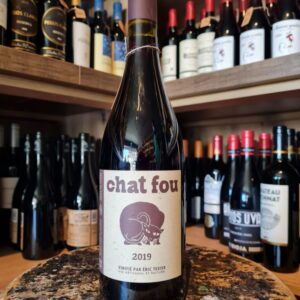 If you were ever sceptical about Organic wines, you have to give this one a try! This wine is Artisanal, Organic, Biodynamic, unfined and unfiltered. All with the aim to do as little intervention as possible and to let the Terroir speak for itself. Eric Texier Chat Fou natural red wine is a coupage of Grenache Tinta, Clairette and Marsanne, from the well known region of Côtes du Rhône.Eric Texier is a vigneron from Brézème, a municipality in the northern area of the Rhone Valley. Texier worked in nuclear engineering but switched to the world of wine in the early 1990s. He practices minimal viticulture and oenology, and attaches special importance to the management of the soils of his vineyards. The result is this superb wine a true example of natural wines and at the forefront of this movement. Eric is not a follower of fashion and speaks vehemently against those who label themselves as natural when it is used as a marketing tool rather than a true desire to understand the terroir. He believes that in most cases all natural wines taste the same! He vinifies all his wines in the same way, using as little intervention as possible to allow the terroir of his different parcels to do the talking. Hope it catches your eye!
If you were ever sceptical about Organic wines, you have to give this one a try! This wine is Artisanal, Organic, Biodynamic, unfined and unfiltered. All with the aim to do as little intervention as possible and to let the Terroir speak for itself. Eric Texier Chat Fou natural red wine is a coupage of Grenache Tinta, Clairette and Marsanne, from the well known region of Côtes du Rhône.Eric Texier is a vigneron from Brézème, a municipality in the northern area of the Rhone Valley. Texier worked in nuclear engineering but switched to the world of wine in the early 1990s. He practices minimal viticulture and oenology, and attaches special importance to the management of the soils of his vineyards. The result is this superb wine a true example of natural wines and at the forefront of this movement. Eric is not a follower of fashion and speaks vehemently against those who label themselves as natural when it is used as a marketing tool rather than a true desire to understand the terroir. He believes that in most cases all natural wines taste the same! He vinifies all his wines in the same way, using as little intervention as possible to allow the terroir of his different parcels to do the talking. Hope it catches your eye! -
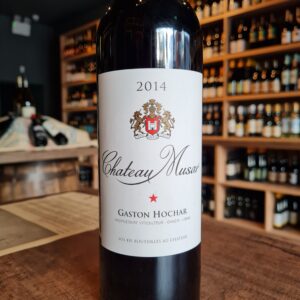 Seven years in the making, Chateau Musar Red is a blend of Cabernet Sauvignon, Carignan and Cinsault from vineyards near the Bekaa Valley villages of Aana and Kefraya on gravelly soils over limestone. Planted from the 1930s onwards, yields are low from these mature bushvines (average age: 40 years):. The varietal components are brought together two years after the harvest; the resulting blend is then placed back in cement tanks before being bottled 12 months later. After 4 years’ bottle maturation in the deep stone cellars of Chateau Musar, the finished wines are released a full seven years after the harvest. Bottled unfined and unfiltered, Chateau Musar Reds are suitable for vegans; they’re also richly-textured and likely to ‘throw a crust’. This is a common feature of most fine wines and is especially true of Musar Red vintages over a decade old. Ideally, bottles should be standing up the night before opening to allow the sediment to settle. After careful decanting (and discarding of sediment, usually in the last centimetre of the bottle) the wine should be allowed to breathe for an hour and served at 18°C with roasts, grills (especially lamb), casseroles, game, and mature cheeses. One of my favourite wines and at somewhate affordable price.
Seven years in the making, Chateau Musar Red is a blend of Cabernet Sauvignon, Carignan and Cinsault from vineyards near the Bekaa Valley villages of Aana and Kefraya on gravelly soils over limestone. Planted from the 1930s onwards, yields are low from these mature bushvines (average age: 40 years):. The varietal components are brought together two years after the harvest; the resulting blend is then placed back in cement tanks before being bottled 12 months later. After 4 years’ bottle maturation in the deep stone cellars of Chateau Musar, the finished wines are released a full seven years after the harvest. Bottled unfined and unfiltered, Chateau Musar Reds are suitable for vegans; they’re also richly-textured and likely to ‘throw a crust’. This is a common feature of most fine wines and is especially true of Musar Red vintages over a decade old. Ideally, bottles should be standing up the night before opening to allow the sediment to settle. After careful decanting (and discarding of sediment, usually in the last centimetre of the bottle) the wine should be allowed to breathe for an hour and served at 18°C with roasts, grills (especially lamb), casseroles, game, and mature cheeses. One of my favourite wines and at somewhate affordable price. -
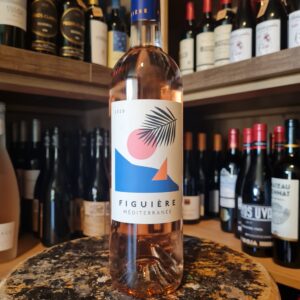 Here is a Provençal estate rosé sure to add some style to your summer! One smell, one sip and you get beamed to the Mediterranean Sea! This delicious Rosé is created by a pioneering Provence domaine of excellence. The family Combard is one of the ambassadors of a new generation of prestigious winemakers. You can smell notes of white flowers that then develop into white peach aromas. The palate expresses the velvety texture of citrus peel and the zestiness of an essential oil. Citrus profile with this wine that is astringent, green, tight and fresh.
Here is a Provençal estate rosé sure to add some style to your summer! One smell, one sip and you get beamed to the Mediterranean Sea! This delicious Rosé is created by a pioneering Provence domaine of excellence. The family Combard is one of the ambassadors of a new generation of prestigious winemakers. You can smell notes of white flowers that then develop into white peach aromas. The palate expresses the velvety texture of citrus peel and the zestiness of an essential oil. Citrus profile with this wine that is astringent, green, tight and fresh. -
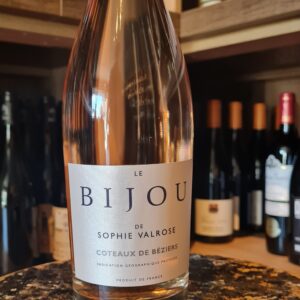 Le Bijou de Sophie Valrose is named after a lady who worked in the Languedoc vineyards during the late 19th century and became something of a local hero. At the time, it was largely women who worked in the vineyards; pruning and harvesting the vines. Sadly these women were often mistreated, overworked and underpaid. Sophie fought for women’s rights and drastically improved the conditions for her fellow female workers in the vineyard in which she worked. Bijou is a tribute to her memory and we share her story on the back of every bottle sold. The grapes are sourced from low-yielding old vines on the sloping hillsides of various vineyards in the Languedoc-Roussillon region of southern France. The areas are made up of old volcanic soils composed of 70% schist, which helps create high-quality grapes with great structure and freshness.Bijou’s flagship wine, a beautiful pale salmon coloured rosé. Elegantly fragrant, with aromas of wild strawberries, citrus and delicate floral notes. Round and creamy on the palate, with ripe red berry flavours and a soft minerality. Elegant and balanced with refreshing acidity and a silky smooth finish. The perfect accompaniment to canapés, white meats, fish and salads.
Le Bijou de Sophie Valrose is named after a lady who worked in the Languedoc vineyards during the late 19th century and became something of a local hero. At the time, it was largely women who worked in the vineyards; pruning and harvesting the vines. Sadly these women were often mistreated, overworked and underpaid. Sophie fought for women’s rights and drastically improved the conditions for her fellow female workers in the vineyard in which she worked. Bijou is a tribute to her memory and we share her story on the back of every bottle sold. The grapes are sourced from low-yielding old vines on the sloping hillsides of various vineyards in the Languedoc-Roussillon region of southern France. The areas are made up of old volcanic soils composed of 70% schist, which helps create high-quality grapes with great structure and freshness.Bijou’s flagship wine, a beautiful pale salmon coloured rosé. Elegantly fragrant, with aromas of wild strawberries, citrus and delicate floral notes. Round and creamy on the palate, with ripe red berry flavours and a soft minerality. Elegant and balanced with refreshing acidity and a silky smooth finish. The perfect accompaniment to canapés, white meats, fish and salads.


